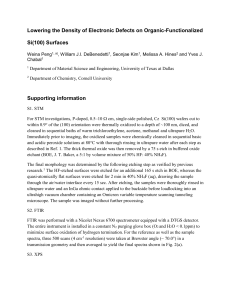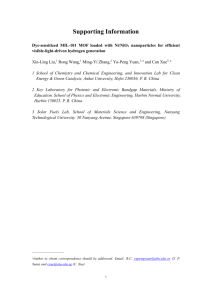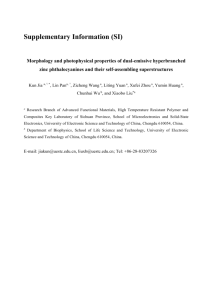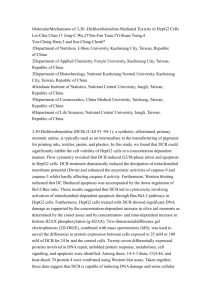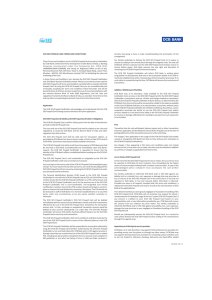AIP Advances Supplemental Information
advertisement
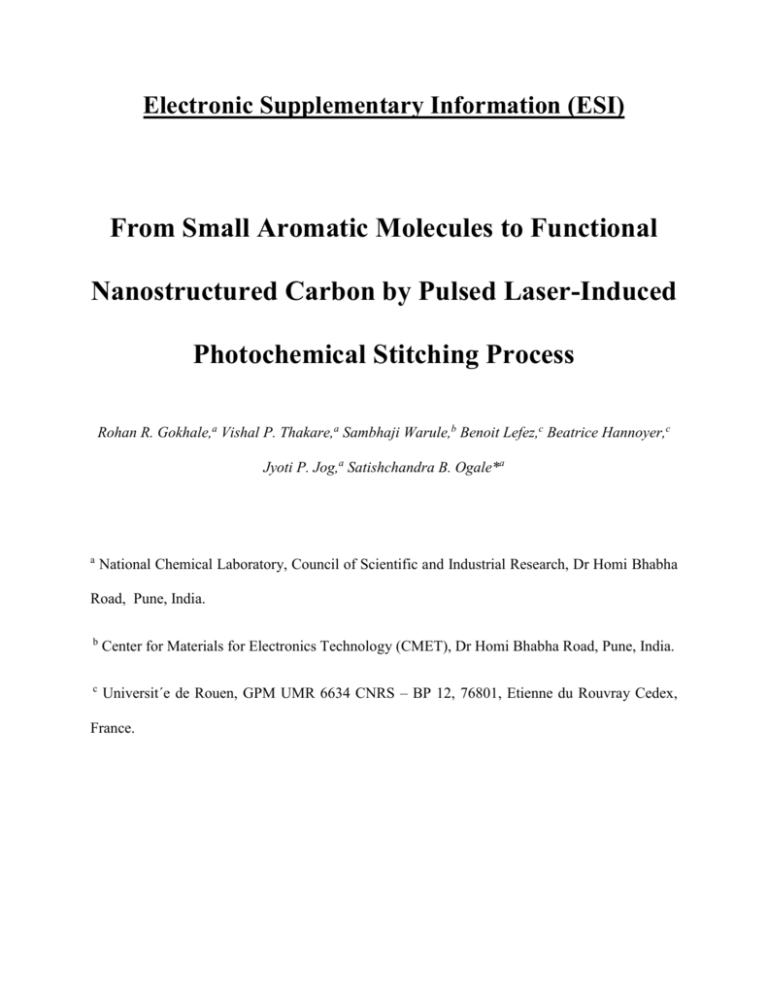
Electronic Supplementary Information (ESI) From Small Aromatic Molecules to Functional Nanostructured Carbon by Pulsed Laser-Induced Photochemical Stitching Process Rohan R. Gokhale,a Vishal P. Thakare,a Sambhaji Warule,b Benoit Lefez,c Beatrice Hannoyer,c Jyoti P. Jog,a Satishchandra B. Ogale*a a National Chemical Laboratory, Council of Scientific and Industrial Research, Dr Homi Bhabha Road, Pune, India. b Center for Materials for Electronics Technology (CMET), Dr Homi Bhabha Road, Pune, India. c Universit´e de Rouen, GPM UMR 6634 CNRS – BP 12, 76801, Etienne du Rouvray Cedex, France. ESI-I Characterization Scanning electron microscopy with Energy-dispersive X-ray spectroscopy (EDX) (FEI Quanta 200 3D) was used for the determination of morphology and elemental composition. X-ray photoelectron spectroscopy (XPS) (ESCA-3000, VG Scientific Ltd. UK, with a 9 channeltron CLAM4 analyzer under vacuum better than 1* 10-8 Torr, Al Ka radiation (1486.6 eV) and a constant pass energy of 50 eV) was employed to study the chemical state of carbon in the materials respectively. X-ray Diffraction (XRD, Philips X’Pert PRO) and Raman spectroscopy (a confocal micro-Raman spectrometer LabRAM ARAMIS Horiba JobinYvon, with laser excitation wavelength of 532 nm) were also used to examine the characteristics of the carbonaceous compounds. Thermogravimetric analysis (TGA) was performed to determine the thermal stability. We also obtained images of the graphitic CNSs by techniques of Field Emission Scanning Electron Microscopy (FESEM, Hitachi S-4200) and High ResolutionTransmission Electron Microscopy (HR-TEM, FEI Tecnai 300). Conductivity measurement was carried out on a pellet by a two probe method. The surface area of carbon was obtained from BET surface area measurements (Quantachrome Quadrasorb automatic volumetric instrument). ESI-II Analysis of Composition (EDAX and XPS) Figure (A) EDAX analysis of carbon obtained from DCB, (B) EDAX of carbon from CB, (C) XPS analysis of carbon from DCB, (D) XPS of carbon from CB The composition and elemental bonding state of the carbonaceous materials obtained from CB and DCB were investigated using Energy-dispersive Analysis of X-rays (EDAX) and X-ray photoelectron spectroscopy (XPS) techniques, respectively. The solid material acquired from DCB was seen to consist mostly of carbon (93-95 %) with some residual chlorine groups from the starting material (Cl- 2-3 at. %) and oxygenated carbons (O-2-3 at %) (Fig.A). The carbon from CB was observed to contain lesser amount of residual -Cl groups (Cl- 0.25 at %) (Fig. 1B). This can be attributed to the single reactive C-Cl site on each molecule of CB as compared to DCB. The extra tallest peak in the same figure is attributed to the Si substrate, which shows up when the film thickness is small. XPS analysis brings out that carbon from DCB exists in the usual sp2 C=C form as confirmed by the fitted C 1s peak at 284.5 eV. The peak at 286.09 may be attributed to the residual C-Cl bonds in the compound (Fig. 1C). Further, the XPS of carbon compound obtained from CB confirms the presence of the sp2 carbon (Fig. 1D). EDAX Data: Composition of Carbon from CB: Composition of Carbon from DCB: Element C Cl O Total Element C Cl O Total Wt % 94.17 0.75 5.08 100 At % 95.86 0.26 3.88 100 Wt % 89.53 8.24 2.23 100 At % 95.25 2.97 1.78 100 ESI-III Thermogravimetric Analysis (TGA) A-CB case; B-DCB case ESI-IV Laser Irradiation studies with variation of time of irradiation, energy flux of the laser pulses and temperature In addition to our moderate energy flux condition of 150 mJ laser energy and a standardized time period of 10 minutes of irradiation, we further irradiated 50 ml of o-DCB (similar to our original experimental procedure in the main paper) at different energy flux values of 80 mJ, 150 mJ and 200 mJ. The increase in this energy signifies an increase in the number of photons per laser pulse. The irradiation under every energy case was carried out for time intervals of 5 mins, 10 mins and 20 mins. We used UV-Visible spectroscopy, Raman Spectroscopy and Transmission Electron Microscopy for analysis of these systems. It was clearly observed that 80 mJ being a very low energy flux, the product formation is very slow in this case since the number of photons per pulse is less as compared to the other cases. Hence no observable product was obtained at any of the time intervals for this energy case. However since the wavelength of the photon (248 nm) is constant for this UV laser, there is a certain onset of the dissociation process and product formation as indicated by the UV-Vis spectra (Fig 1.). Fig 1 shows the UV-Vis absorption of the irradiated liquid at 80 mJ for 5, 10 and 20 mins in comparison with pure o-DCB. This spectra clearly indicates product formation. Fig 1. UV-Vis Abs spectra at 80 mJ laser energy for different time intervals Similar process was repeated for energy flux of 150 mJ. The UV-Visible spectra for this case is shown in Figure 2. Fig 2. UV-Visible Absorption spectra at 150 mJ for different time intervals Fig 2 demonstrates that with increase in energy flux (150 mJ), the number of photons increases and in turn the rate of product formation also increases. This is clear from the increased intensity of absorption in this case. Isolable carbon product can be obtained after 10 mins and 20 mins in this case. Fig 3 shows the similar case of irradiation at 200 mJ laser energy flux Fig 3. UV-Vis Abs spectra at 200 mJ laser energy for different time intervals Fig 3 shows a proportionate increase in product formation due to a much higher energy of 200 mJ. The rate of product formation increases further because of a large number of photons per pules. It has been observed that after a certain initial time period of product formation the rate of the reaction decreases. This will occur naturally because of the formation of a black optically absorbing compound which will absorb all the incoming photons. Fig 4. Raman spectra of carbon obtained by irradiation of DCB at 200 mJ for 10 mins Fig 5. Raman spectra of carbon obtained by irradiation of DCB at 200 mJ for 20 mins TEM images of the Carbon Nanospheres for the 200 mJ-20 mins case High Temperature Case We also irradiated o-DCB at higher temperature (100 degree Celsius) for 10 mins to observe the effect of heat during the photochemical process. No appreciable difference was observed Fig 5. Raman spectra of carbon obtained by irradiation of DCB at 100 degree for 10 mins TEM images of CNSs obtained at high temperature irradiation of DCB

